Ruth Ellen Gruber's Blog, page 11
March 10, 2012
From New York not Europe, but relevant
By Ruth Ellen Gruber
My friend Julian Voloj, who was born in Germany, has been photographing former synagogue building in New York City for nearly a decade. He has amassed an important collection of images -- 12 of which are on display at an exhibit in Sag Harbor, NY.

My friend Julian Voloj, who was born in Germany, has been photographing former synagogue building in New York City for nearly a decade. He has amassed an important collection of images -- 12 of which are on display at an exhibit in Sag Harbor, NY.
Read full article
One would think that because American Judaism is alive and well in New York City, there would be lots of people advocating to protect some of these sites. But Voloj found himself in "a race against the clock to make sure what I was documenting would still be there. There was one place that was torn down before I could get inside."
Of the 1200 photos that Voloj took on his expeditions around New York, he has selected 12 for his exhibition at Temple Adas Israel in Sag Harbor.
"One photo is of a now-supermarket that used to be a Jewish site, and you can see two lions and The Ten Commandments," said Voloj. "Another is a cross nailed on a Star of David, and there's one image from the oldest Jewish cemetery in North America, in Chinatown. There's one gravestone that stands alone. It's a nice link because the gravestone goes back to the roots of North American Judaism."
Published on March 10, 2012 01:48
March 7, 2012
New App -- Jewish Geography Game
By Ruth Ellen Gruber
Jono David, who has a vast library of photographs he has taken of Jewish heritage sites, has turned is pictures into an "Jewish Geography" quiz game app for I-Pad and other devices. Looks fun! I will buy it and see how I do!

Jono David, who has a vast library of photographs he has taken of Jewish heritage sites, has turned is pictures into an "Jewish Geography" quiz game app for I-Pad and other devices. Looks fun! I will buy it and see how I do!
Published on March 07, 2012 03:45
February 18, 2012
Jewish Travel goes Academic......
By Ruth Ellen Gruber
Scholars at the Herbert D. Katz Center for Advanced Judaic Studies at the University of Pennsylvania are analyzing Jewish travel in a fellowship program called "On the Road: Travel in Jewish History." Robert Leiter writes about the program in The Jewish Exponent. He reports that there were about 170 applications, which were whittled down to 12 scholars for the first semester and 14 for the second, now under way. (Full disclosure -- I applied for a fellowship but was not accepted.)

Scholars at the Herbert D. Katz Center for Advanced Judaic Studies at the University of Pennsylvania are analyzing Jewish travel in a fellowship program called "On the Road: Travel in Jewish History." Robert Leiter writes about the program in The Jewish Exponent. He reports that there were about 170 applications, which were whittled down to 12 scholars for the first semester and 14 for the second, now under way. (Full disclosure -- I applied for a fellowship but was not accepted.)
Travel as ennobling -- an educational pursuit that broadens knowledge and sharpens perceptions -- is a 20th century concept, according to German-born scholar Martin Jacobs. [...]
Jacobs joined Ora Limor of the Open University in Jerusalem and Joshua Levinson of Jerusalem's Hebrew University, who first broached the topic, in fashioning the proposal they eventually presented to David Ruderman, the head of the center. [...]
Two scholars who consider modern-day notions of Jewish travel are Jackie Feldman, a native New Yorker who now lectures on social anthropology at Ben-Gurion University of the Negev; and Nils Roemer, a non-Jew born in Germany, who teaches Jewish subjects at the University of Texas in Dallas.
Published on February 18, 2012 09:55
February 10, 2012
Poland -- Travel story on Lodz
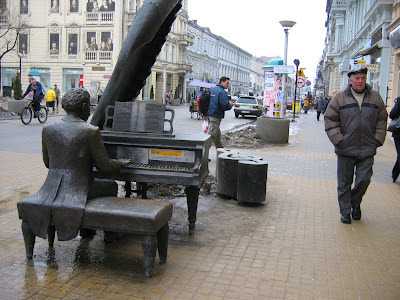 Artur Rubinstein street sculpture monument. Photo (c) Ruth Ellen Gruber
Artur Rubinstein street sculpture monument. Photo (c) Ruth Ellen GruberBy Ruth Ellen Gruber
The New York Jewish Week runs a lively travel story by Hilary Larson on Lodz, Poland, highlighting the city's Jewish heritage as well as its new spaces and places -- which include Manufaktura, a big shopping center in the transformed red-brick factory that was once run by Lodz's wealthiest Jewish industrialist, I.K. Poznanski...
This onetime outpost of the Russian and German Empires was among the world's most Jewish cities before the Holocaust, with a quarter-million Jews, a good third of the city's total. Every year, thousands of heritage travelers come to bear witness to Lodz's wartime ghetto and the largest Jewish cemetery in Europe.
So fixed is that mournful image that it takes a mental leap to consider what Europeans already know: Lodz is suddenly the coolest place in Poland.
"It's where all the hipsters and artists are going," said my Polish friend Piotr. "They are in Warsaw for the jobs, in Krakow for the universities. But they come to Lodz for the scene." [...]
This so-called "City of Four Cultures" (Polish, Jewish, German and Russian) is polyglot and full of surprises. There are 19th-century Orthodox churches, baroque Teutonic mansions, Soviet housing blocks with underground cafes. Though Jews are few today, Jewishness continues to pervade the city — a subtle but persistent overlay of nostalgia, and a belatedly appreciated cultural influence.I'm glad to see Lodz get such coverage. I have always greatly enjoyed my visits to the city and walks down ruler-straight Piotrkowski street, looking at the old mansions and the street sculpture of Rubinstein, Tuwim and others.
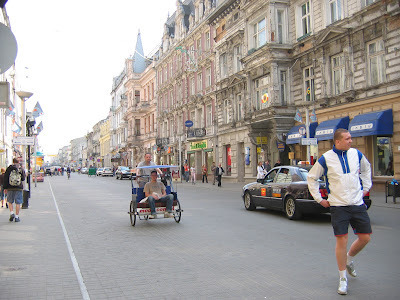 Piortrkowski st. Photo (c) Ruth Ellen Gruber)
Piortrkowski st. Photo (c) Ruth Ellen Gruber)Larson doesn't mention however, two of the key Jewish and "Jewish" sights..... the large and fascinating Jewish cemetery, with Poznanski's immense domed tomb, and the "Jewish" restaurant Anatewka, which, since I first saw it, has been one of the Platonic ideals for me of the "virtually Jewish world"..... where, the first time I visited, in 2005, the waiters were dressed as Hasids, and where guests are (or were) all given little figurines of Jews clutching coins as sort of favors.
Published on February 10, 2012 11:51
February 6, 2012
Jewish Heritage Europe web site
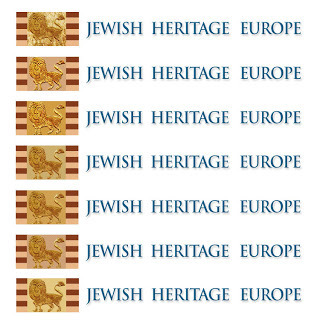
By Ruth Ellen Gruber
I've been neglecting this blog for a little while, as I've been involved in getting the Jewish Heritage Europe web site that I am coordinating for the Rothschild Foundation (Hanadiv) Europe ready for launch....
I'm happy to say that JHE is now online and functioning (more or less) fully... there are still a few teething problems, as expected, and I still have a lot of information to load on the home pages of the 48 countries covered.
JHE is an expanding web portal to a wide range of news, information and resources concerning Jewish monuments and heritage sites all over Europe.JHE aims to aggregate information, shed light on Jewish heritage issues, and stimulate discussion and exchanges among professionals and the interested public.
It has a constant newsfeed -- and I will be cross posting on this blog from it (and vice versa).
The new JHE builds on, revamps and expands a previous version of the site that was launched after the major 2004 conference in Prague on the future of Jewish heritage in Europe and was coordinated by Sharman Kadish, Syd Greenberg, and Samuel D. Gruber.
The current version was conceived as a follow-up to the seminar held in Bratislava, Slovakia in March 2009 that discussed the state of Jewish heritage sites in Europe as well as strategies for their restoration, use and upkeep.
As I reported on this blog at the time, that seminar, attended by international Jewish heritage experts as well as by representatives from Jewish communities in more than a dozen countries, resulted in a statement of specific "Best Practices" about how to deal with Jewish heritage sites.
Published on February 06, 2012 03:08
January 23, 2012
Slovakia -- in the Presov Synagogue, a musician deals with a cellphone interruption
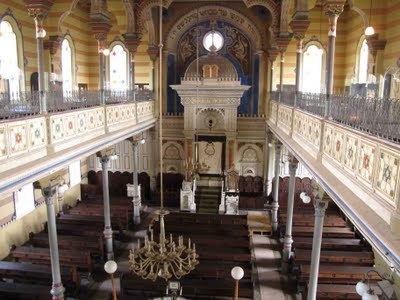 Presov synagogue. Photo (c) Ruth Ellen Gruber
Presov synagogue. Photo (c) Ruth Ellen GruberBy Ruth Ellen Gruber
This is too good not to post..... at a concert last year in the magnificent synagogue in Presov, in eastern Slovakia, a young violinist (or violist), Lukas Kmit, deals with consummate class with a cellphone interruption..... there have been suggestions that this might be a viral ad for Nokia -- but it looks and sounds real to me! (You can hear the concert audience).
Published on January 23, 2012 01:16
January 17, 2012
Czech Republic -- vandalism at Puklice Jewish cemetery
By Ruth Ellen Gruber
Vandals have damaged or toppled about 10 gravestones in the centuries-old Jewish cemetery in Puklice, near Jihlava. The cemetery is listed as a national cultural monument and had recently undergone restoration. Police are investigating the vandalism, which was discovered in the first week of January.
The Puklice cemetery, which includes about 100 gravestones, is one of the oldest in the Czech Republic, probably founded in the 15th century. The oldest legible gravestone dates from 1699. The small Jewish quarter in the village itself is largely intact, with the remains of a mikvah and a former synagogue/school (now a residence).
Jaroslav Klenovsky, who oversees Jewish heritage in Moravia for the Federation of Jewish communities, told Czech media that the vandalism was likely not a specifically anti-semitic attack, but the work of "young offenders."
You can see a video of the damage HERE.
Vandals have damaged or toppled about 10 gravestones in the centuries-old Jewish cemetery in Puklice, near Jihlava. The cemetery is listed as a national cultural monument and had recently undergone restoration. Police are investigating the vandalism, which was discovered in the first week of January.
The Puklice cemetery, which includes about 100 gravestones, is one of the oldest in the Czech Republic, probably founded in the 15th century. The oldest legible gravestone dates from 1699. The small Jewish quarter in the village itself is largely intact, with the remains of a mikvah and a former synagogue/school (now a residence).
Jaroslav Klenovsky, who oversees Jewish heritage in Moravia for the Federation of Jewish communities, told Czech media that the vandalism was likely not a specifically anti-semitic attack, but the work of "young offenders."
You can see a video of the damage HERE.
Published on January 17, 2012 01:28
January 13, 2012
Ukraine -- Shtetl trippin'
By Ruth Ellen Gruber
The JTA's young correspondent Alex Weisler, who just finished a 6-month stint roving in Europe, has written a pair of stories about his whirlwind visit to his ancestral shtetl, Shatsk, in Ukraine, as well as on Jewish heritage travel in Ukraine in general -- from the perspective of a non-Jewish guide, Alex Dunai.
It reminds me of the article I wrote for UPI many years ago when I first visited my own ancestral town on my father's side, Radauti.
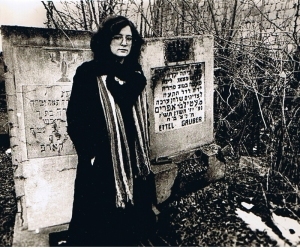 My first visit to Radauti, at the grave of my great-grandmother
My first visit to Radauti, at the grave of my great-grandmother
And of the various other such stories I've written for other publications, including a JTA story on a more recent visit to Radauti. Here's the of the story I wrote for JTA about visiting Kalvarija, my ancestral town on my mother's side....

The JTA's young correspondent Alex Weisler, who just finished a 6-month stint roving in Europe, has written a pair of stories about his whirlwind visit to his ancestral shtetl, Shatsk, in Ukraine, as well as on Jewish heritage travel in Ukraine in general -- from the perspective of a non-Jewish guide, Alex Dunai.
For me and my family, Shatsk has always seemed like an impossibly exotic travel destination. I found it hard to believe that, as the Ukrainian census informed me, about 6,000 people lived there. Or that it had a nightclub called Sinatra and several ATMs.
But somehow, you can drive to Shatsk -- and you don't even need a souped-up DeLorean. After just four hours on roads whose quality varied from poor to middling to dear-God-is-this-a-road, my mother, our guide and I had traded the comparatively cosmopolitan Lviv -- which was feverishly preparing for the 2012 European soccer championship -- for the dusty roads of Shatsk, which lay dormant in the absence of summer's rush of tourists. [...]
For 22 years, I had wondered what Shatsk meant for me. Was it a living, breathing place? Or just the graveyard of my family's past? Was it some hell my family had escaped from? Or the bucolic paradise they spent decades in America pining after?
I'm aware of the challenges that come with heritage tourism. I spent 36 hours in Shatsk. Who is to say I've learned anything substantive about a place to which I parachute in, hunt around for some information and snap a few photos? How can I be sure that my newfound connection to Ukraine and my long-lost relatives is something more than fetishizing the past and longing for an idealized Shatsk that may have never existed?
But if heritage tourism is an imperfect science, it's an important one. As a Jew in New York, it's easy to lose sight of history -- to view the past as a neat arc that started at Ellis Island, paused on a stoop in Brooklyn and triumphantly culminated in the green pastures of Westchester County or Long Island. If we consider the Old Country at all, it's of a sanitized variety: Pop "Fiddler on the Roof" in the DVD player, rinse and repeat.
It reminds me of the article I wrote for UPI many years ago when I first visited my own ancestral town on my father's side, Radauti.
 My first visit to Radauti, at the grave of my great-grandmother
My first visit to Radauti, at the grave of my great-grandmotherAnd of the various other such stories I've written for other publications, including a JTA story on a more recent visit to Radauti. Here's the of the story I wrote for JTA about visiting Kalvarija, my ancestral town on my mother's side....
December 16, 1999
Ten Years After the Wall
Memories of lost family are conjured when walking in footsteps of the past
By Ruth E. Gruber
On a frosty November morning, I walked around the two massive, ruined synagogues that form a unique surviving Jewish complex in Kalvarija, a small, sleepy town in southern Lithuania near the border with Poland.
One of the synagogues was built in the early 18th century. Its roof had fallen in and its bottom windows were bricked up, but it was possible to see arches and other architectural detail and decoration.
The other, built in about 1803, was more or less intact, but crumbling. Between the two stood a red brick building, a former rabbi's house and a cheder, or Jewish school, with a big Star of David above the door.
As I have done in hundreds of other cities, towns and villages in more than a dozen countries, I took pictures of the synagogues from every angle.
With my eye focused through my camera, I didn't watch where I was walking. Suddenly, I tripped over a broken brick, half buried in the uneven yard, and went crashing to the ground.
Trying to save my cameras, I ended up twisting my ankle so that I could hardly walk.
The injury took weeks to heal fully, but everyone told me that my spill was beshert -- fated -- and maybe it was.
Kalvarija is the town from which my great-grandfather, Pesach Susnitsky, emigrated some 120 years ago, ending up in the small town of Brenham, Texas.
In Brenham, Pesach became Philip. He was the patriarch of a huge family of children, including my grandmother, who was born in Brenham, and a pious pillar of the Jewish community.
In Brenham, he helped found a Jewish congregation. The little wooden synagogue that was built in 1894 still stands.
When he left Kalvarija in about 1880, Jews made up more than 80 percent of the town's population. By 1939, it had dropped to about 25 percent, but still about 1,000 Jews lived in the town.
No Jews live there today, and I must say that given the depressing and bloody history of the town and region during World Wars I and II, and decades of later Soviet domination, I am enormously thankful that my great-grandfather had the courage to leave when he did.
Still, the buildings I was photographing were not just fascinating sites of Jewish heritage in general: they were the places where my ancestors worshiped and studied.
The streets of the town, with their small, mainly low wooden houses, and the central square dominated by a big, white church with two ornate towers, were the streets and square where my ancestors walked.
I had driven there with a friend after spending the night near the Polish town of Suwalki, about 20 miles to the south. Until a few years ago, such a day trip from Poland to Kalvarija would have been difficult if not impossible.
For one thing, American citizens today do not need a visa to enter Lithuania. While Kalvarija is the first town in Lithuania across the border from Poland, the border crossing-point was opened only four years ago.
I didn't have a real genealogical agenda for my visit -- I just wanted to see the town. But I had hoped to spend much of the day walking through the quiet streets, poking into corners and possibly talking to local people.
My injured ankle cramped my capabilities, though -- and here's where beshert comes in.
An old woman told us where the Jewish cemetery was located, on the other side of the little Sheshupa River that winds through the town, and my friend and I decided to drive straight there.
Pesach Susnitsky died in Texas in 1939 at the age of 83. Several years ago, I visited his grave in the Jewish cemetery in Brenham.
I had little hope of finding any Susnitsky graves in Kalvarija, but I was eager to visit the cemetery just to see it.
We found a small, fenced-in, triangular plot of ground right in front of a huge electric grid, which contained several dozen simple tombstones, some of them toppled.
Hobbling, I starting photographing the site. Just then an old man came by, wheeling a bicycle.
"I know everything, everything," he smiled. All his teeth were capped in gold. "I remember everything how it was."
He propped up his bike and began to talk. He described how the cemetery used to extend much, much further, stone after stone, all the way down to the river, but the Germans destroyed it, and most remaining stones were stolen.
Now on top of the area, there are ugly, poor barracks where people live -- with no indoor plumbing, they have to walk 50 yards or so to toilets. Pigs and dogs frolic around. A man passed by leading a cow.
Of the remaining graves, the only mausoleum, he said, was that of a certain Menashe who was a "millionaire."
I asked the old man if he remembered the Susnitsky family -- and he did.
"Of course! There were a lot of Susnitskys here, a lot." Particularly, he said, before the war, there were two Susnitsky brothers in town, Alter and Yankel, who must have been nephews or great-nephews of Pesach. "Alter was a big, tall man," he said. "Yankel was small, curved over and had a hunch back." He demonstrated, scooping out his own body.
The brothers lived together in a big house on a hill, he said -- and then he led us there to see it. Indeed, it was one of the most imposing wooden houses in the village. Undergoing some renovation, it even sported a satellite dish.
Both brothers were killed when the Germans deported the Jews to nearby Mariampole during World War II, he told us.
The old man said all the houses on this street were occupied by Jews, and that Jews lived all over the town. "So many, so many!" He gestured forlornly.
He was clearly nostalgic for past times -- and the disappearance of the Jewish community represented for him a change for the worse. Nonetheless, in describing the Jews in town, he used the Polish term Zydek or "little Jew" -- a term Jews regard as pejorative.
The Jews in Kalvarija were "good people," and "wealthy," the man said, they took care of each other and everyone got on with everyone.
"They were called Yankele, Alterke, Menashe, Meyshke," he recalled. "They would say, 'Oy vey, oy vey.'"
Published on January 13, 2012 03:49
January 7, 2012
Way off geographic topic but relevant: lost synagogues in New York
By Ruth Ellen Gruber
I -- and others -- have written much about and, hey, even taken part in, the process of seeking out, rediscovering and documenting former synagogues that have been transformed for other use in Europe.....Here's a fascinating story by Benjamin Kabin Weitzenkorn from the local newspaper the Queens Chronicle about a woman's search for "lost synagogues" in outer districts of New York City.
Levitt found that many of the former Jewish sites still -- as in Europe -- often retained evidence of their original function.
Read full article
I -- and others -- have written much about and, hey, even taken part in, the process of seeking out, rediscovering and documenting former synagogues that have been transformed for other use in Europe.....Here's a fascinating story by Benjamin Kabin Weitzenkorn from the local newspaper the Queens Chronicle about a woman's search for "lost synagogues" in outer districts of New York City.
On her birthday in 1999, Ellen Levitt decided to look for her mother's former synagogue in Flatbush. The building was still there, but the congregation was gone, replaced by a Pentecostal Christian one. The news dismayed her mother, but for Levitt, it sparked an idea: to find and document other former synagogues, and to create a record so others could find them as well.
In 2009, her project became a book called "The Lost Synagogues of Brooklyn," and this past November, Levitt released her latest installment, "The Lost Synagogues of the Bronx and Queens."
As the project grew, Levitt discovered that synagogues that had not been burned or torn down were adapted for other uses. Some became private homes, one is a correctional facility, another is used for city maintenance and one is even a mosque — but most are now churches. Read moreIn New York, these transformations usually came about because of normal demographic changes that saw Jews moving from one neighborhood to another (often from small towns to cities or from to urban centers and suburbs), while in post-World War II Europe synagogues were most often orphaned by the murder of their community in the Holocaust, suppression by post-war communist regimes, or emigration of survivors. In Bulgaria, for example, whose Jews survived the Shoah, synagogues were left abandoned when almost all Jews moved to Israel.
Levitt found that many of the former Jewish sites still -- as in Europe -- often retained evidence of their original function.
The former Corona Hebrew School on 53rd Avenue, for example, boasts large stars of David on either side of its gate. Names written in Hebrew are displayed on pillars and walls on the porch. After the Jewish congregation left, the building became a private residence and music studio, and was home to Madonna, pre-fame, in the late 1970s.
Another great example is the former Young Israel of Laurelton on 228th Street. It's a boxy 1956 building that displays a cornerstone with the Hebrew and secular dates. But its most intriguing feature is the huge window above the main entrance in the shape of a Jewish star, an emblem that the Jamaica-Queens Wesleyan Church has kept as is.
Read full article
Published on January 07, 2012 01:20
January 5, 2012
Poland/Lithuania -- Cooperation between Jewish cultural institutions
By Ruth Ellen Gruber
At the end of December, three key Jewish cultural institutes in Poland and Lithuania signed a cooperation agreement that will enhance and expand the Virtual Shtetl portal, an excellent and up-to-date news source for Jewish heritage and culture events and issues in Poland.
Virtual Shtetl reports:

At the end of December, three key Jewish cultural institutes in Poland and Lithuania signed a cooperation agreement that will enhance and expand the Virtual Shtetl portal, an excellent and up-to-date news source for Jewish heritage and culture events and issues in Poland.
Virtual Shtetl reports:
The co-operation agreement concluded between the Jewish Historical Institute Association, the Museum of the History of Polish Jews and the Center for Jewish Culture and Information in Vilnius governs the co-operation with regard to the administration of the 'Virtual Shtetl' portal.
Under this international agreement, the Lithuanian version of the 'Virtual Shtetl' portal will be created. The Center for Jewish Culture and Information in Vilnius, together with the teams from the Museum of the History of Polish Jews and the Jewish Historial Institute Association, will research the history of Jewish communities that lived in the territory of contemporary Lithuania and will promote the knowledge about Jewish cultural monuments in Lithuania on the 'Virtual Shtetl' portal.
It is the beginning of a very promising co-operation and it will be the first time that a foreign organization contributes so extensively to the development and administration of the 'Virtual Shtetl' portal. The concluded agreement paves the way to international research and cultural projects on the history of Jews in Eastern and Central Europe.
Published on January 05, 2012 06:40



